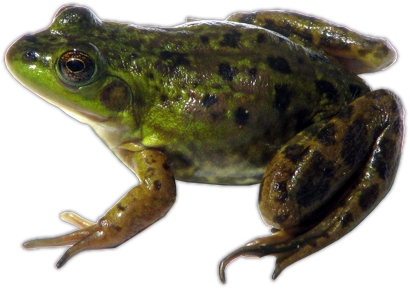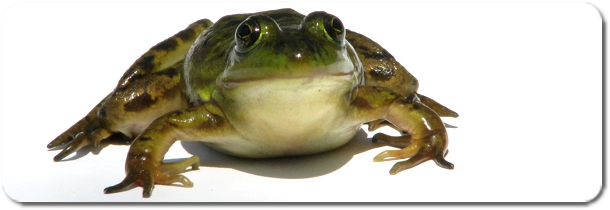Mink Frog

What it looks like
The Mink Frog is a medium sized frog. The body of an adult can be as long as 8 cm. The colour is green with brown patches. Male Mink Frogs have a much larger ear drum, called a tympanum, than the females.
Look-alikes
Green Frogs and Northern Leopard Frogs can look like Mink Frogs. The Mink Frog can be told from the Green Frog because it has no stripes on its legs. The Northern Leopard Frog has large black spots all over its back.
Name
The Mink Frog gets its name because it smells like a mink. The mink is mammal in the weasel family. (If you don't know what a mink smells like, think of rotten onions.)
Scientific Name
The Mink Frog's scientific name is Lithobates septentrionalis. Learn what that means on this page: Scientific Names.
Where it lives
Mink Frogs live along the edges of streams, large ponds and small lakes. They are found in the central part of eastern North America. In Manitoba they are only found in the southeast corner around Whiteshell and Nopiming Provincial Parks.
Where Mink Frogs live in North America.
Habits
Mink Frogs spend most of their time in water or close to the water's edge. This is one kind of frog that really does sit on water lily pads. They sit and wait for prey to fly by. Mink Frogs spend winter on the bottom of rivers, ponds or lakes.
Food web
Mink Frogs eat insects of many kinds. Most of their food is insects that fly over the pond, like dragonflies in the daytime and moths at night.
Many birds and mammals will not eat a Mink Frog because they taste and smell bad. Snakes are their main enemies. The tadpoles are eaten by fish, snakes, large water insects and shore birds.
Life cycle
Mink Frogs mate and lay eggs in June and early July. They breed in large ponds, streams or along the edges of small lakes. Male Mink Frogs stay in their own small area, their territory. They don't usually gather together to call for mates.
| Hear the Mink Frog mating call: |
The females lay their eggs in large bunches attached to water plants. Each female can lay 500 eggs.The eggs hatch in 7 days. The tadpoles will not change to froglets until the next summer. They stay a tadpole for more than a year, nearly 400 days. They grow to be very large by their second summer. A Mink Frog tadpole may be as long as 8 cm. They change into large froglets, with bodies about 5 cm long, in July or August.
Numbers
No one knows how many Mink Frogs may be in Manitoba, but there are lots of them around Whiteshell and Nopiming Parks. There can be hundreds of them around the edge of a large pond.
Special things
The Mink Frog has a bad smell, like a mink or rotten onions, that helps protect it from enemies. The eyes of a Mink Frog are further on top of its head than other frogs. This helps it to look up to hunt insects that are flying over head.

A Mink Frog with it's upward pointing eyes.
How to find Mink Frogs
Listen for males calling from late June to early August. The best time to hear them is evening or early in the morning, but they may call throughout the day. Your best chance of seeing a Mink Frog is looking along the edge of water bodies. They often sit on water lily pads or other floating plants.
Use by people
Mink Frogs are only found in a small part of southeastern Manitoba and are not used by people.
| Next frog: Wood Frog | Back to: Amphibians and Reptiles Front Page |
